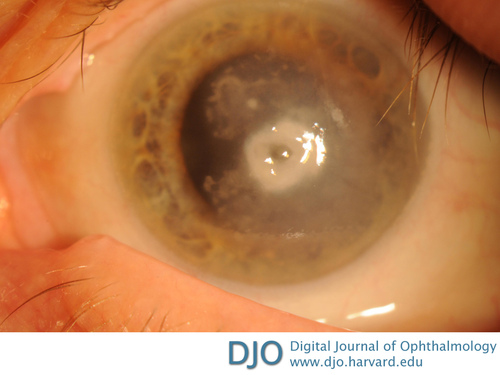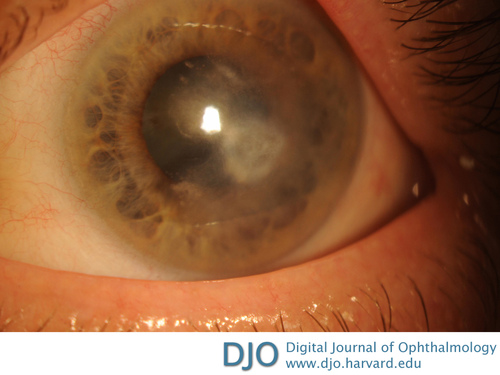|
|
 |
 |
 |
 |
|
|
Magnusiomyces capitatus: a new and emerging pathogen linked to keratomycosis
Digital Journal of Ophthalmology
2017
Volume 23, Number 3
September 14, 2017
DOI: 10.5693/djo.02.2017.04.001
|
Printer Friendly
Download PDF |
|
|


 Ankit Shah, MD
Ankit Shah, MD | Cornea and External Disease Service, Department of Ophthalmology, Ohio State University College of Medicine Thomas Mauger, MD | Cornea and External Disease Service, Department of Ophthalmology, Ohio State University College of Medicine
|
|
|
| Abstract | | We describe our experience managing a case of fungal keratitis in a 71-year-old immunocompetent woman. Intracameral cultures isolated Magnusiomyces capitatus, a dimorphic commensal microbe with limited pathogenicity, in an immune competent patient. Repeated corneal cultures for bacteria and fungus were negative. Initial broad-spectrum topical fortified antibiotics were eventually escalated to include topical natamycin and voriconazole and oral voriconazole. The patient underwent emergent corneal transplantation, but recurrent infection eventually required anterior chamber washout and intracameral injection of amphotericin B. A combination of topical, systemic, intracameral administration of voriconazole, intracameral administration of amphotericin B, anterior chamber washout, and penetrating keratoplasty were required to clear the infection. | | | Introduction | | Keratomycosis is a common cause of infectious keratitis that poses difficult diagnostic and therapeutic challenges. Risk factors for infection include systemic immunosuppression as well as topical steroid use, trauma, and injury from vegetative matter. Yeast infections from Candida species are more common in northern climates and classically present with an epithelial plaque. In contrast, filamentous (septate and nonseptate) fungal infections feature feathery borders and satellite lesions. Treatment of keratomycosis often requires a combination of antifungals (eg, natamycin, amphotericin B, triazole). We report our experience treating a case of keratomycosis in an immunocompetent 71-year-old woman caused by the newly emerging pathogen Magnusiomyces capitatus. | | | Case Report | A 71-year-old woman with a past medical history of sarcoidosis presented at the Ohio State University with subacute onset of left eye pain, photophobia, discharge, and decreased vision. The patient had previously undergone successful corneal transplantation in the right eye (5 years earlier) to remove a corneal scar following an infection. She used daily wear soft contact lenses at that time, to which the infection was attributed, but she reported not having worn any contact lenses for the past 5 years. While a diagnosis of sarcoidosis had been established, the patient was not taking any steroids or immunosuppressive medications. There was no significant family history, and review of systems was unremarkable aside from her ocular complaints. The patient denied any topical or systemic steroid use, contact lens wear, trauma, or vegetation injury prior to symptom onset. Visual acuity was 20/40 in the right eye but had declined to counting fingers in the left eye due to a large central ring infiltrate with irregular, feathery borders, satellite lesions and a large corresponding epithelial defect (Figure 1). Insensitivity to initial broad-spectrum topical antibiotics, and a chronic clinical course led to a presumed diagnosis of fungal keratitis. Cultures were obtained on several occasions, with consistently negative results. Topical natamycin 5% ophthalmic suspension and voriconazole 1% suspension as well as oral voriconazole 200 mg twice daily were started initially. Intracameral voriconazole (50 μg/0.1 ml) was also injected into the anterior chamber until the patient’s clinical course stabilized (Figure 2). A recurrence of the infection 6 weeks after presentation ultimately required a penetrating keratoplasty. Host cornea pathology demonstrated fungal elements, but cultures did not provide species. Topical antifungals were continued for 3 weeks after surgery.
Two months after her corneal transplant and 4 months after initial presentation, the patient presented with a recurrent dense, deep corneal endothelial infiltrate and associated hypopyon with fungal balls in the anterior chamber (Figure 3). B-scan ultrasound did not reveal vitreous inflammation (Figure 4). The patient underwent anterior chamber cultures, and repeat intracameral injection of voriconazole. Repeat cultures remained negative. Due to a progressive and persistent clinical course, the patient underwent another anterior chamber washout, with injection of intracameral amphotericin B (5 ?g/0.1ml), vancomycin (1 mg/0.1mL), and ceftazadime (2 mg/0.1mL). Cultures of the aqueous grew Magnusiomyces capitatus. A combination treatment protocol with intracameral amphotericin B and topical and systemic voriconazole was required to clear the infection.
At her most recent follow-up examination, approximately 9 months after initial presentation and 3 months after repeat penetrating keratoplasty and cataract surgery, the infection was cleared, with best-corrected visual acuity of 20/60 and no evidence of recurrent infection. | |

Figure 1
Clinical photograph of the patient’s left eye on presentation showing a large round central corneal infiltrate with irregular feathery borders and satellite lesions.
|
|

Figure 2
Healed corneal ulcer with residual corneal scarring after aggressive topical and intracameral therapy.
|
|

Figure 3
Recurrent infection in the graft with a new large dense infiltrate, keratic precipitates, and hypopion.
|
|

Figure 4
Ultrasound image of the left eye showing no significant vitreous inflammation or debris suggestive of endophthalmitis.
|
|
| Discussion | M. capitatus (formerly Geotrichum capitatum) is a filamentous yeast-like fungus that is a common commensal component of human skin flora and sputum. Its pathogenicity has been associated with immunosuppression; prognosis is very poor, with a high mortality rate. Risk factors include neutropenia, catheterization, cytotoxic chemotherapy, and the use of broad-spectrum antibiotics.(1) Disseminated infection by this organism has been linked to fungemia, endocarditis, and pulmonary infections, specifically in patients with hematologic disorders.(2) Local infection by M. capitatus in immunocompetent patients is extremely rare, and ophthalmic infection in this population has not been reported in the literature.(3) Our case represents the first documented culture positive ocular infection caused by this organism.
Morphologically, this yeast produces rapidly proliferating, flat, white colonies with acute-angled hyphae and abundant conidia formation.(5) The organism persisted in this patient’s cornea despite intensive topical and systemic antifungal treatment. A review of the literature confirmed successful treatment of blood-borne infection with amphotericin B and flucytosine or amphotericin B and voriconazole.(4) Unfortunately, resistance of M. capitatus to both imidazole and polyene has been reported.(6) However, in vitro antimicrobial sensitivities should be scrutinized and may not correlate with in vivo ophthalmic formulations, which are often higher concentrations than tested in the lab. Thus, drugs shown to be resistant on antifungal sensitivity testing may be efficacious when injected intracamerally or intravitreally. This case confirms anecdotal evidence that a combination of amphotericin B and voriconazole effectively treats infectious keratitis.(7)
We recommend an aggressive approach in the treatment of this microbe, including multiple drugs and routes of administration. Topical and oral antifungals may not eradicate the infection by themselves. Amphotericin B is strongly recommended in the treatment of M. capitatus ophthalmic infections over natamycin, which has better efficacy in the treatment of filamentary fungal keratitis.(8) Although newer agents, such as voriconazole, have excellent ocular penetration when administered orally, intrastromal and intracameral agents provide higher site-specific concentration of the antimicrobial agent. In cases of refractory fungal keratitis with minimal improvement despite local and systemic antifungal treatment, intracameral administration of amphotericin B to prevent progression of ulceration has been effective.(9) Stability of the clinical course often takes many months, and caution is recommended prior to pursing definitive surgical intervention.
Literature Search
PubMed was most recently searched on September 5, 2016, without date restriction, for English-language results, using the following terms: Magnusiomyces capitatus, Geotrichum capitatum, and infectious keratitis. | | | References | 1. Yapo-Kouadio CG, Hasseine L, Goubaux B, Gari-Toussaint M. Disseminated fungal infection due to Magnusiomyces capitatus in a liver graft patient [in French]. J Mycol Med 2016;26:261-4.
2. Fernández-Ruiz M, Guinea J, Puig-Asensio M, et al; CANDIPOP Project; GEIH-GEMICOMED (SEIMC) and REIPI. Fungemia due to rare opportunistic yeasts: data from a population-based surveillance in Spain. Med Mycol 2016 Aug 5; doi: 10.1093/mmy/myw055. Epub ahead of print.
3. Özkaya-Parlakay A, Cengiz AB, Karadağ-Öncel E, et al. Geotrichum capitatum septicemia in a hematological malignancy patient with positive galactomannan antigen: case report and review of the literature. Turk J Pediatr 2012;54:674-8.
4. Gao GX, Tang HL, Zhang X, et al. Invasive fungal infection caused by Geotrichum capitatum in patients with aute lymphoblastic leukemia: a case study and literature view. J Clin Exp Med 2015;8:14228-35.
5. Arendrup MC1 Boekhout T, Akova M, Meis JF, Cornely OA, Lortholary O; European Society of Clinical Microbiology and Infectious Diseases Fungal Infection Study Group; European Confederation of Medical Mycology. ESCMID and ECMM joint clinical guidelines for the diagnosis and management of rare invasive yeast infections. Clin Micro Inf 2014;20 Suppl 3:76-98.
6. Savini V, Catavitello C, Balbinot A, et al. Multidrug-resistant Geotrichum capitatum from a haematology ward. Mycoses 2011;54:542-3.
7. Girmenia C, Pagano L, Martino B, et al; GIMEMA Infection Program. Invasive infections caused by Trichosporon species and Geotrichum capitatum in patients with hematological malignancies: a retrospective multicenter study from Italy and review of the literature. J Clin Microbiol 2005;43:1818-28.
8. Solanki S, Rathi M, Khanduja S, Dhull CS, Sachdeva S, Phogat J. Recent trends: medical management of infectious keratitis. Oman J Ophthalmol 2015;8:83-5.
9. Sharma B, Kataria P, Anand R, et al. Efficacy profile of intracameral amphotericin B: the often-forgettable step. Asia Pac J Ophthalmol (Phila) 2015;4:360-6. | |
|
 |
 |
 |

|
|
 Welcome, please sign in
Welcome, please sign in  Welcome, please sign in
Welcome, please sign in